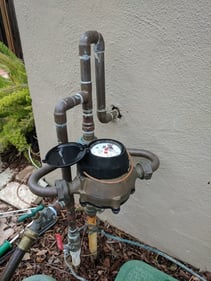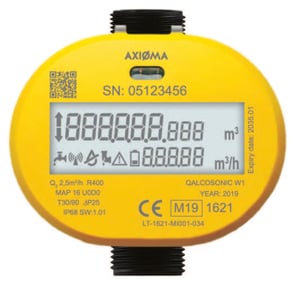Navigating Water Management: Ultrasonic Smart vs. Mechanical Meters
by A D Riley, on Apr 11, 2024 3:35:05 PM
Choosing the right tool for informed water monitoring and management
These days, efficient water management is a key component of sustainable infrastructure. Local government officials, tasked with the oversight of their region's water infrastructure, shoulder the responsibility for making sure that water is managed effectively, equitably, and sustainably.
Central to this task are the mechanisms by which water consumption is measured and monitored. For decades, mechanical meters have served as the cornerstone of this process. These meters, with their traditional design and mechanical components, have long been the trusted choice for tracking water usage. However, as the digital age unfolds, new technology arrives in the form of the smart water meter.
Smart meters, particularly ultrasonic variants, represent a paradigm shift in water metering technology. Unlike their mechanical counterparts, smart meters operate without moving parts, offering heightened durability and sustained accuracy over their lifespan. These advanced devices provide a comprehensive view of network data, facilitating precise billing and streamlined management practices. Not only that, but their remote reading capabilities eliminate the need for additional devices, simplifying the monitoring process for officials and utility providers alike.
We aim to highlight the distinctions between these two approaches. Let's explore the advantages and implications of both mechanical and smart meters in the pursuit of efficient water management.
Mechanical meters - the traditional workhorses of water measurement
Mechanical water meters operate on fundamental principles of mechanical engineering. These meters rely on physical components, such as gears and chambers, to quantify the flow of water through a system. Here's a closer look at their defining features, advantages, and drawbacks.
Definition and basic functionality
Mechanical meters function by employing mechanical components to measure the volume of water passing through them. Water flows through chambers or gears within the meter, causing them to rotate. The rotation is then translated into a measurement of water volume, typically displayed on a dial or register.
Pros and cons
Mechanical meters boast a track record of reliability. Other benefits include:
- They are relatively inexpensive to install
- They have historically demonstrated stability in performance and require minimal professional intervention for maintenance
- They offer a long service life, reducing the need for frequent replacements
- They can be upgraded; existing manifold meters can become smart with a small attachment, making them adaptable to evolving technological advancements
- On some occasions, mechanical meters can provide fast and accurate readings, with intervals as short as 15 minutes
That said, there are several cons to consider:
- Over time, mechanical meters may experience reduced accuracy due to wear and tear on their mechanical components
- Mechanical meters may occasionally measure airflow, leading to inaccurate readings
- Flow obstruction within the meter can cause pressure drops and further inaccuracies
- Regular maintenance, including the use of strainers to protect measuring elements, is necessary to uphold performance standards
- Maintenance requirements
Despite their limitations, mechanical meters remain a reliable option for water measurement, particularly in areas where sophisticated digital infrastructure may be lacking. Their straightforward design and robust construction make them well-suited to environments with minimal maintenance resources. However, it's essential to adhere to regular maintenance schedules to ensure optimal performance and accuracy over time.
Smart meters - embracing a digital future
Digital transformation is here to stay, and the innovative tech behind smart water meters is a shining example. Smart meters are significantly changing the way we monitor and conserve water resources. Let's take a closer look.
Definition and advanced features
Smart water meters leverage digital technology to provide a range of advanced features beyond traditional mechanical meters. They employ ultrasonic technology, IoT integration, and real-time data transmission capabilities to offer unparalleled accuracy and efficiency in water measurement. Intelligent alarms enable the swift detection of leaks, bursts, and reverse flows, minimising non-revenue water loss and optimising distribution network performance.
Pros and cons
The adoption of smart water meters presents numerous benefits, including:
- Enhanced data collection and analysis, leading to improved resource distribution and reduced operational costs
- Pinpoint accuracy and stability over time, with no moving parts to maintain
- Real-time monitoring capabilities empower customers to track their water usage, receive timely leak notifications, and access personalised water-saving tips
- Potential for significant water conservation through proactive leak detection and consumer awareness
- Data accuracy and real-time monitoring
However, there are some considerations to keep in mind:
- Higher initial costs compared to mechanical meters may pose financial barriers for some communities
- Privacy concerns may arise from the continuous monitoring and sharing of water usage data, particularly if shared with third parties
- Technical issues, such as reliance on reliable internet connectivity and potential interoperability challenges, may impact meter performance and customer satisfaction
- Deployment and maintenance costs, coupled with infrastructure and skill gaps, can pose additional challenges for widespread adoption
One of the standout features of smart water meters is their data accuracy and real-time monitoring capabilities. By providing precise measurements and timely notifications of anomalies, these meters empower both utility providers and consumers to take proactive steps in water conservation and management.
Potential for water conservation
Smart water meters are a powerful tool in the ongoing efforts to conserve water resources. Through real-time monitoring, leak detection, and consumer engagement, these meters enable communities to identify and address inefficiencies in water usage, ultimately leading to reduced waste and enhanced sustainability.
Key considerations for local governments
When you're weighing up the potential benefits of transitioning to smart water meters, there are several things to keep in mind:
Budget constraints
One of the foremost concerns for local governments is navigating the financial implications of adopting smart water metering technology. While the upfront costs may present a barrier, it's essential to weigh these against the long-term savings and efficiency gains enabled by smart meters. Exploring funding opportunities, grants, and financing options can help alleviate budgetary constraints and facilitate the transition to smarter water infrastructure.
Connectivity
As the transition from 2G & 3G to newer generations of communication networks, such as 4G and 5G, continues, rural communities often face the necessity of updating their infrastructure to accommodate these advancements.
Long-term sustainability goals
Smart water metering aligns closely with the long-term sustainability goals of local governments, offering a powerful tool for conserving water resources and reducing environmental impact. By investing in advanced metering technology, communities can take proactive steps towards achieving water conservation targets, enhancing resilience to drought, and promoting environmental stewardship.
Integration with existing infrastructure
Efficient integration of smart water meters with existing infrastructure is essential for the success of any implementation initiative. It's important to assess compatibility with legacy systems, address interoperability challenges, and ensure communication between meters, data management platforms, and utility networks. Collaboration with stakeholders and technology providers is essential to streamline integration efforts and minimise disruptions.
Community engagement and acceptance
It's essential for local governments to communicate openly with residents, addressing concerns about privacy, data security, and billing accuracy. Providing educational resources, soliciting feedback, and fostering open dialogue can build trust and promote acceptance of new metering technology within the community.
Regulatory compliance and reporting requirements
Compliance with regulatory standards and reporting requirements is non-negotiable for local governments implementing smart water metering solutions. It's essential to ensure that meters meet industry standards, adhere to data privacy regulations, and facilitate accurate reporting for regulatory bodies. Proactive monitoring and compliance management are essential to avoid penalties and maintain public trust.
Conclusion - steering towards smarter water management
Efficient and sustainable water management is an ongoing objective, meaning the choice between traditional mechanical meters and innovative smart meters is a consideration that can't be ignored. As local governments grapple with budget constraints, sustainability goals, and community acceptance, the decision to embrace smart water metering technology is increasingly seen as a pivotal opportunity to revolutionise the way we monitor, conserve, and distribute water resources.
By leveraging the advanced features of smart meters, including real-time monitoring, data accuracy, and proactive leak detection, communities can achieve significant strides towards water conservation and environmental stewardship. However, success hinges on careful consideration of key factors such as budget constraints, integration with existing infrastructure, and regulatory compliance.
Keen to find out more? Explore our range of Ultrasonic Smart Meters, and don't hesitate to reach out if you'd like to learn more about them.




